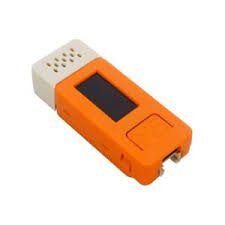In this article we look at an add-on hat for the M5StickC and M5StickC-plus called the ENV hat.
The env hat is able to detect the temperature, humidity, air pressure and magnetic field. This product relates via I2C protocol which allows you to obtain 4 types of environment data thru just 2pins, together with the tiny body, makes it a powerful application for environment data collecting.
It comprises of the following sensors
DHT12 : The DHt12 is an upgraded version of the classic DHT11 humidity temperature sensor, it is fully downward compatible, more precise and adds an I2C interface.
BMP280 : The BMP280 is an absolute barometric pressure sensor especially designed for mobile applications.
BMM150 : The BMM150 is a low power and low noise 3-axis digital geomagnetic sensor to be used in compass applications.
This is what the hat looks like with a MStickC
Purchase
You can get the kit below for $35 – it includes the m5StickC, a couple of hats and other useful accessories
Include
– 1x M5StickC
– 1x 20cm USB Type-C cable
– 1x ENV Hat II
– 1x SPK Hat
– 1x WALL/1515
– 1x Brick
– 1x Watch Belt
M5StickC Development Kit with Hat
You simply fit the hat to the M5StickC like the picture below

Code
If you download the M5StickC library in the Arduino IDE
You can also get tit from the github location
[codesyntax lang=”cpp”]
/*
note: need add library Adafruit_BMP280 from library manage
Github: https://github.com/adafruit/Adafruit_BMP280_Library
*/
#include <M5StickC.h>
#include "DHT12.h"
#include <Wire.h>
#include "Adafruit_Sensor.h"
#include <Adafruit_BMP280.h>
#include "bmm150.h"
#include "bmm150_defs.h"
DHT12 dht12;
BMM150 bmm = BMM150();
bmm150_mag_data value_offset;
Adafruit_BMP280 bme;
void calibrate(uint32_t timeout)
{
int16_t value_x_min = 0;
int16_t value_x_max = 0;
int16_t value_y_min = 0;
int16_t value_y_max = 0;
int16_t value_z_min = 0;
int16_t value_z_max = 0;
uint32_t timeStart = 0;
bmm.read_mag_data();
value_x_min = bmm.raw_mag_data.raw_datax;
value_x_max = bmm.raw_mag_data.raw_datax;
value_y_min = bmm.raw_mag_data.raw_datay;
value_y_max = bmm.raw_mag_data.raw_datay;
value_z_min = bmm.raw_mag_data.raw_dataz;
value_z_max = bmm.raw_mag_data.raw_dataz;
delay(100);
timeStart = millis();
while((millis() - timeStart) < timeout)
{
bmm.read_mag_data();
/* Update x-Axis max/min value */
if(value_x_min > bmm.raw_mag_data.raw_datax)
{
value_x_min = bmm.raw_mag_data.raw_datax;
// Serial.print("Update value_x_min: ");
// Serial.println(value_x_min);
}
else if(value_x_max < bmm.raw_mag_data.raw_datax)
{
value_x_max = bmm.raw_mag_data.raw_datax;
// Serial.print("update value_x_max: ");
// Serial.println(value_x_max);
}
/* Update y-Axis max/min value */
if(value_y_min > bmm.raw_mag_data.raw_datay)
{
value_y_min = bmm.raw_mag_data.raw_datay;
// Serial.print("Update value_y_min: ");
// Serial.println(value_y_min);
}
else if(value_y_max < bmm.raw_mag_data.raw_datay)
{
value_y_max = bmm.raw_mag_data.raw_datay;
// Serial.print("update value_y_max: ");
// Serial.println(value_y_max);
}
/* Update z-Axis max/min value */
if(value_z_min > bmm.raw_mag_data.raw_dataz)
{
value_z_min = bmm.raw_mag_data.raw_dataz;
// Serial.print("Update value_z_min: ");
// Serial.println(value_z_min);
}
else if(value_z_max < bmm.raw_mag_data.raw_dataz)
{
value_z_max = bmm.raw_mag_data.raw_dataz;
// Serial.print("update value_z_max: ");
// Serial.println(value_z_max);
}
Serial.print(".");
delay(1);
}
value_offset.x = value_x_min + (value_x_max - value_x_min)/2;
value_offset.y = value_y_min + (value_y_max - value_y_min)/2;
value_offset.z = value_z_min + (value_z_max - value_z_min)/2;
}
void setup() {
// put your setup code here, to run once:
M5.begin();
Wire.begin(0,26);
M5.Lcd.setRotation(3);
M5.Lcd.fillScreen(BLACK);
M5.Lcd.setCursor(0, 0, 2);
M5.Lcd.println("ENV TEST");
pinMode(M5_BUTTON_HOME, INPUT);
if(bmm.initialize() == BMM150_E_ID_NOT_CONFORM) {
Serial.println("Chip ID can not read!");
while(1);
} else {
Serial.println("Initialize done!");
}
if (!bme.begin(0x76)){
Serial.println("Could not find a valid BMP280 sensor, check wiring!");
while (1);
}
calibrate(10);
Serial.print("\n\rCalibrate done..");
}
uint8_t setup_flag = 1;
void loop() {
// put your main code here, to run repeatedly:
float tmp = dht12.readTemperature();
float hum = dht12.readHumidity();
M5.Lcd.setCursor(0, 20, 2);
M5.Lcd.printf("Temp: %2.1f Humi: %2.0f%%", tmp, hum);
bmm150_mag_data value;
bmm.read_mag_data();
value.x = bmm.raw_mag_data.raw_datax - value_offset.x;
value.y = bmm.raw_mag_data.raw_datay - value_offset.y;
value.z = bmm.raw_mag_data.raw_dataz - value_offset.z;
float xyHeading = atan2(value.x, value.y);
float zxHeading = atan2(value.z, value.x);
float heading = xyHeading;
if(heading < 0)
heading += 2*PI;
if(heading > 2*PI)
heading -= 2*PI;
float headingDegrees = heading * 180/M_PI;
float xyHeadingDegrees = xyHeading * 180 / M_PI;
float zxHeadingDegrees = zxHeading * 180 / M_PI;
Serial.print("Heading: ");
Serial.println(headingDegrees);
Serial.print("xyHeadingDegrees: ");
Serial.println(xyHeadingDegrees);
Serial.print("zxHeadingDegrees: ");
Serial.println(zxHeadingDegrees);
M5.Lcd.setCursor(0, 40, 2);
M5.Lcd.printf("headingDegrees: %2.1f", headingDegrees);
float pressure = bme.readPressure();
M5.Lcd.setCursor(0, 60, 2);
M5.Lcd.printf("pressure: %2.1f", pressure);
delay(100);
if(!setup_flag){
setup_flag = 1;
if(bmm.initialize() == BMM150_E_ID_NOT_CONFORM) {
Serial.println("Chip ID can not read!");
while(1);
} else {
Serial.println("Initialize done!");
}
if (!bme.begin(0x76)){
Serial.println("Could not find a valid BMP280 sensor, check wiring!");
while (1);
}
calibrate(10);
Serial.print("\n\rCalibrate done..");
}
if(digitalRead(M5_BUTTON_HOME) == LOW){
setup_flag = 0;
while(digitalRead(M5_BUTTON_HOME) == LOW);
}
}
[/codesyntax]
When you run this it should display various readings on the display

